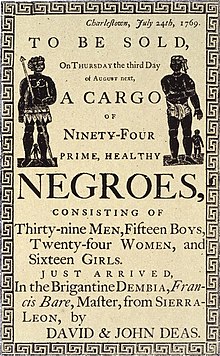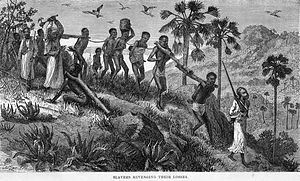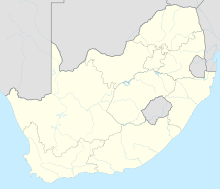Portal:Pan-Africanism/Selected history
Instructions
The layout design for these subpages is at Portal:Pan-Africanism/Selected history/Layout.
- Add a new article to the next available subpage.
- The "blurb" for each article should be approximately 10 lines, for appropriate formatting in the portal main page.
- Update "max=" to new total for its {{Random portal component}} on the main page.
Articles list
Selected history 1
Portal:Pan-Africanism/Selected history/1


The history of Africa begins with the emergence of hominids, archaic humans and – at least 200,000 years ago – anatomically modern humans (Homo sapiens), in East Africa, and continues unbroken into the present as a patchwork of diverse and politically developing nation states. The earliest known recorded history arose in the Kingdom of Kush, and later in Ancient Egypt, the Sahel, the Maghreb and the Horn of Africa.
Following the desertification of the Sahara, North African history became entwined with the Middle East and Southern Europe while the Bantu expansion swept from modern day Cameroon (West Africa) across much of the sub-Saharan continent in waves between around 1000 BC and 0 AD, creating a linguistic commonality across much of the central and Southern continent.
During the Middle Ages, Islam spread west from Arabia to Egypt, crossing the Maghreb and the Sahel. Some notable pre-colonial states and societies in Africa include the Ajuran Empire, D'mt, Adal Sultanate, Warsangali Sultanate, Kingdom of Nri, Nok culture, Mali Empire, Songhai Empire, Benin Empire, Oyo Empire, Ashanti Empire, Ghana Empire, Mossi Kingdoms, Mutapa Empire, Kingdom of Mapungubwe, Kingdom of Sine, Kingdom of Sennar, Kingdom of Saloum, Kingdom of Baol, Kingdom of Cayor, Kingdom of Zimbabwe, Kingdom of Kongo, Empire of Kaabu, Kingdom of Ile Ife, Ancient Carthage, Numidia, Mauretania, and the Aksumite Empire. At its peak, prior to European colonialism, it is estimated that Africa had up to 10,000 different states and autonomous groups with distinct languages and customs.
From the mid-7th century, the Arab slave trade saw Muslim Arabs enslave Africans. Following an armistice between the Rashidun Caliphate and the Kingdom of Makuria after the Second Battle of Dongola in 652 AD, they were transported, along with Asians and Europeans, across the Red Sea, Indian Ocean, and Sahara Desert.
Selected history 2
Portal:Pan-Africanism/Selected history/2

Africa has the longest record of human habitation in the world. The first hominins emerged 6-7 million years ago, and among the earliest anatomically modern human skulls found so far were discovered at Omo Kibish.
European archaeology, as well as that of North Africa, is generally divided into the Stone Age (comprising the Lower Paleolithic, the Middle Paleolithic, the Upper Paleolithic, the Mesolithic, and the Neolithic), the Bronze Age, and the Iron Age. For Africa south of the Sahara, African archaeology is classified in a slightly different way, with the Paleolithic generally divided into the Early Stone Age, the Middle Stone Age, and the Later Stone Age. After these three stages come the Pastoral Neolithic, the Iron Age and then later historical periods.
Africa's prehistory has been largely ignored, with the exception of research into early human evolution. However, it is overseen by the PanAfrican Archaeological Association, whose members consist of professional archaeologists from all over Africa.
Selected history 3
Portal:Pan-Africanism/Selected history/3


The Atlantic slave trade or transatlantic slave trade involved the transportation by slave traders of enslaved African people, mainly to the Americas. The slave trade regularly used the triangular trade route and its Middle Passage, and existed from the 16th to the 19th centuries. The vast majority of those who were enslaved and transported in the transatlantic slave trade were people from central and western Africa, who had been sold by other West Africans to Western European slave traders (with a small number being captured directly by the slave traders in coastal raids), who brought them to the Americas. The South Atlantic and Caribbean economies especially were dependent on the supply of secure labour for the production of commodity crops, making goods and clothing to sell in Europe. This was crucial to those western European countries which, in the late 17th and 18th centuries, were vying with each other to create overseas empires.
The Portuguese were the first to engage in the Atlantic slave trade in the 16th century. In 1526, they completed the first transatlantic slave voyage to Brazil, and other European countries soon followed. Shipowners regarded the slaves as cargo to be transported to the Americas as quickly and cheaply as possible, there to be sold to work on coffee, tobacco, cocoa, sugar and cotton plantations, gold and silver mines, rice fields, construction industry, cutting timber for ships, in skilled labour, and as domestic servants. The first Africans imported to the English colonies were classified as "indentured servants", like workers coming from England, and also as "apprentices for life". By the middle of the 17th century, slavery had hardened as a racial caste, with the slaves and their offspring being legally the property of their owners, and children born to slave mothers were also slaves. As property, the people were considered merchandise or units of labour, and were sold at markets with other goods and services.
Selected history 4
Portal:Pan-Africanism/Selected history/4

The Arab slave trade was the intersection of slavery and trade in the Arab world, mainly in Western Asia, North Africa, East Africa and Europe. This barter occurred chiefly between the medieval era and the early 20th century. The trade was conducted through slave markets in these areas, with the slaves captured mostly from Africa's interior and Southern Europe.
Selected history 5
Portal:Pan-Africanism/Selected history/5

The First Pan-African Conference was held in London from 23 to 25 July 1900 (just prior to the Paris Exhibition of 1900 "in order to allow tourists of African descent to attend both events"). Organized primarily by the Trinidadian barrister Henry Sylvester Williams, it took place in Westminster Town Hall (now Caxton Hall) and was attended by 37 delegates and about 10 other participants and observers from Africa, the West Indies, the US and the UK, including Samuel Coleridge Taylor (the youngest delegate), John Alcindor, Dadabhai Naoroji, John Archer, Henry Francis Downing, and W. E. B. Du Bois, with Bishop Alexander Walters of the AME Zion Church taking the chair. Du Bois played a leading role, drafting a letter ("Address to the Nations of the World") to European leaders appealing to them to struggle against racism, to grant colonies in Africa and the West Indies the right to self-government and demanding political and other rights for African Americans.
Selected history 6
Portal:Pan-Africanism/Selected history/6

| Independent |
The Scramble for Africa was the occupation, division, and colonization of African territory by European powers during the period of New Imperialism, between 1881 and 1914. It is also called the Partition of Africa and by some the Conquest of Africa. In 1870, only 10 percent of Africa was under formal European control; by 1914 it had increased to almost 90 percent of the continent, with only Ethiopia (Abyssinia) and Liberia still being independent. There were multiple motivations including the quest for national prestige, tensions between pairs of European powers, religious missionary zeal and internal African native politics.
The Berlin Conference of 1884, which regulated European colonisation and trade in Africa, is usually referred to as the ultimate point of the scramble for Africa. Consequent to the political and economic rivalries among the European empires in the last quarter of the 19th century, the partitioning, or splitting up of Africa was how the Europeans avoided warring amongst themselves over Africa. The later years of the 19th century saw the transition from "informal imperialism" by military influence and economic dominance, to direct rule, bringing about colonial imperialism.
Selected history 7
Portal:Pan-Africanism/Selected history/7
| Battle of Isandlwana | |||||||
|---|---|---|---|---|---|---|---|
| Part of the Anglo–Zulu War | |||||||
 A depiction of Lt's Melvill and Coghill fleeing the Battle of Isandlwana with the Queen's Colour, taken from the Illustrated London News. | |||||||
| |||||||
| Belligerents | |||||||
|
| Zulu Kingdom | ||||||
| Commanders and leaders | |||||||
|
Overall commander: Maj. Gen. Lord Chelmsford Subordinate commanders: Bvt. Lt-Col. Henry Pulleine † Bvt. Col. Anthony Durnford † |
Overall commander: Ntshingwayo kaMahole Khoza Subordinate commanders: Vumindaba kaNthati Mavumengwana kaNdlela Zibhebhu kaMapitha | ||||||
| Strength | |||||||
|
No.2 Column: British: 14 Native + colonial: c. 511 No.3 Column: British: 734 Native + colonial: c. 578 1,837 men total. In addition to the troops above, an indeterminate number of civilians (wagon drivers, servants, etc.) were also present. |
Zulu Impi: about 20,000 c. 10,000 to 15,000 engaged Reserve: 4,000 to 5,000 to Rorke's Drift | ||||||
| Casualties and losses | |||||||
|
Over 1,300 killed: 52 officers 727 British regulars 471 others including: 133 European Colonial troops 2 artillery pieces captured |
Approx. 1,000–2,500 killed 2,000 wounded. | ||||||
Location of Isandlwana in present-day South Africa | |||||||

The Battle of Isandlwana (alternative spelling: Isandhlwana) on 22 January 1879 was the first major encounter in the Anglo–Zulu War between the British Empire and the Zulu Kingdom. Eleven days after the British commenced their invasion of Zululand in South Africa, a Zulu force of some 20,000 warriors attacked a portion of the British main column consisting of about 1,800 British, colonial and native troops and perhaps 400 civilians. The Zulus were equipped mainly with the traditional assegai iron spears and cow-hide shields, but also had a number of muskets and old rifles. The British and colonial troops were armed with the modern Martini-Henry breech-loading rifle and two 7-pounder (3-inch, 76 mm) mountain guns deployed as field guns, as well as a Hale rocket battery. Despite a vast disadvantage in weapons technology, the Zulus defeated the British, killing over 1,300 troops, including all those out on the forward firing line.
The battle was a decisive victory for the Zulus and caused the defeat of the first British invasion of Zululand. The British Army had suffered its worst defeat against an indigenous foe with vastly inferior military technology.
Selected history 8
Portal:Pan-Africanism/Selected history/8 Jim Crow laws were state and local laws that enforced racial segregation in the Southern United States. All were enacted in the late 19th and early 20th centuries by white Democratic-dominated state legislatures after the Reconstruction period, the laws were enforced until 1965. In practice, Jim Crow laws mandated racial segregation in all public facilities in the states of the former Confederate States of America, starting in the 1870s and 1880s, and were upheld in 1896, by the U.S. Supreme Court's "separate but equal" legal doctrine for facilities for African Americans, established with the court's decision in the case of Plessy vs. Ferguson. Moreover, public education had essentially been segregated since its establishment in most of the South, after the Civil War (1861–65).
Selected history 9
Portal:Pan-Africanism/Selected history/9 The Haitian Revolution (French: Révolution haïtienne [ʁevɔlysjɔ̃ ajisjɛ̃n]) was a successful anti-slavery and anti-colonial insurrection by self-liberated slaves against French colonial rule in Saint-Domingue, now the sovereign nation of Haiti. It began on 22 August 1791, and ended in 1804 with the former colony's independence. It involved blacks, mulattoes, French, Spanish, and British participants—with the ex-slave Toussaint L'Ouverture emerging as Haiti's most charismatic hero. It was the only slave uprising that led to the founding of a state which was both free from slavery, and ruled by non-whites and former captives. It is now widely seen as a defining moment in the history of racism in the Atlantic World.
Its effects on the institution of slavery were felt throughout the Americas. The end of French rule and the abolition of slavery in the former colony was followed by a successful defense of the freedoms they won, and, with the collaboration of free persons of color, their independence from white Europeans. It represents the largest slave uprising since Spartacus's unsuccessful revolt against the Roman Republic nearly 1,900 years earlier. It challenged long-held European beliefs about alleged black inferiority and about enslaved persons' capacity to achieve and maintain their own freedom. The rebels' organizational capacity and tenacity under pressure inspired stories that shocked and frightened slave owners in the hemisphere.
Selected history 10
Portal:Pan-Africanism/Selected history/10
Ghana Empire Wagadou | |||||||||
|---|---|---|---|---|---|---|---|---|---|
| c. 700–c. 1240 | |||||||||
 The Ghana Empire at its greatest extent | |||||||||
| Capital | Koumbi Saleh | ||||||||
| Common languages | Soninke, Malinke, Mande | ||||||||
| Religion | African traditional religion, Islam | ||||||||
| Government | Monarchy | ||||||||
| Ghana | |||||||||
• 700 | Kaya Magan Cissé | ||||||||
• 790s | Majan Dyabe Cisse | ||||||||
• 1040–1062 | Ghana Bassi | ||||||||
• 1203–1235 | Soumaba Cisse | ||||||||
| Historical era | Middle Ages | ||||||||
• Established | c. 700 | ||||||||
• Conquered by Sosso/Submitted to the Mali Empire | c. 1240 | ||||||||
| Area | |||||||||
| 1067 est. | 1,600 km2 (620 sq mi) | ||||||||
| |||||||||
| Today part of | |||||||||
The Ghana Empire (c. 700 until c. 1240), (Ghana or Ga'na being the title of its ruler), was located in the area of present-day southeastern Mauritania and western Mali. Complex societies based on trans-Saharan trade with salt and gold had existed in the region since ancient times, but the introduction of the camel to the western Sahara in the 3rd century A.D. opened the way to great changes in the area that became the Ghana Empire. By the time of the Muslim conquest of North Africa in the 7th century the camel had changed the ancient, more irregular trade routes into a trade network running from Morocco to the Niger river. The Ghana Empire grew rich from this increased trans-Saharan trade in gold and salt, allowing for larger urban centres to develop. The traffic furthermore encouraged territorial expansion to gain control over the different trade-routes.
When Ghana's ruling dynasty began remains uncertain; it is mentioned for the first time in written records by Muḥammad ibn Mūsā al-Khwārizmī in 830. In the 11th century the Cordoban scholar Abuof travelled to the region and gave a detailed description of the kingdom. He claimed that the Ghana could "put 200,000 men into the field, more than 40,000 of them archers", and noted they had cavalry forces as well.
As the empire declined it finally became a vassal of the rising Mali Empire at some point in the 13th century. When the Gold Coast in 1957 became the first country in sub-Saharan Africa to regain its independence from colonial rule, it renamed itself in honor of the long-gone empire.
Selected history 11
Portal:Pan-Africanism/Selected history/11
| Part of a series on |
| Traditional African religions |
|---|
 |
Traditional African religions have faced persecution from the proponents of different ideologies. Adherents of these religions have been forcefully converted to Islam and Christianity, demonized and marginalized. The atrocities include killings, waging war, destroying of sacred places, and other atrocious actions.
After the establishment of Islam, its rapid expansion and conquests displaced traditional African religions either by conversion or conquest. Traditional African religions have influenced Islam in Africa, and Islam is considered as having more commonality with traditional African religions, but conflict has occurred, especially due to Islam's monotheistic stance and the rise of Muslim reformers such as Askia.
In the Senegambia region, the Serer people who held "a strong connection to their ancient religious past" became the targets of Islamic jihads and persecution from the 11th to the 19th-century resulting in the Battle of Fandane-Thiouthioune.
Traditional African religions are tolerant of other gods, which allows general co-existence for multiple religions. This has been regarded by some authors to be another reason behind the rise of other religions in Africa. Most followers of traditional religions accommodated Islam during the start of its spread in Africa, but in West Africa, it was not until the coming of colonialism that Islam gained mass appeal, transforming even groups with historical animosity towards Islamic domination into Muslim communities.
In many instances, conflicting groups chose to align with Muslim armies against other African communities.
| “ | ...during the nineteenth century, Christian missionaries became active in Africa and Oceania. Attempts by Christian missionaries to convert nonbelievers to Christianity took two main forms: forced conversions and proselytizing. | ” |
| — Garrick Bailey, James Peoples , — Bailey, Garrick; Peoples, James, Essentials of Cultural Anthropology, 3rd ed. Cengage Learning (2013), p. 268, ISBN 9781133603566 [1] | ||
| “ | The role of Christian missionaries are a private interest group in European colonial occupation of Africa was a significant one...Collectively their activities promoted division within traditional African societies into rival factions...the picture denigrated African culture and religion... | ” |
| — Festus Ugboaja Ohaegbulam , — Ohaegbulam, Festus Ugboaja, Towards an Understanding of the African Experience from Historical and Contemporary Perspectives, University Press of America (1990), p. 161, ISBN 9780819179418 [2] | ||
| “ | A religion of Middle Eastern origin, Islam reached Africa via the northern region of the continent by means of conquest. The Islamic wars of conquest that would lead to the Islamization of North Africa occurred first in Egypt, when in about 642 CE the country fell to the invading Muslim forces from Arabia. Over the next centuries, the rest of the Maghreb would succumb to Jihadist armies...The notion of religion conversion, whether by force or peaceful means, is foreign to indigenous African beliefs...Islam, however, did not become a religion of the masses by peaceful means. Forced conversion was an indispensable element of proselytization. | ” |
| — Toyin Falola, Adebayo Oyebade , — Falola, Toyin; Oyebade, Adebayo, Hot Spot: Sub-Saharan Africa, ABC-CLIO (2010), p. 7, ISBN 9780313359712 [3] | ||
| “ | African traditional religion went through and survived this type of persecution at the hands of Christianity and Islam... | ” |
| — Darrol M. Bryant, Rita H. Mataragnon, — Bryant, M. Darrol; Mataragnon, Rita H., (cont. M. Darrol Bryant), The Many faces of religion and society, Paragon House Publishers (1985), p. 100, ISBN 9780913757208 | ||

